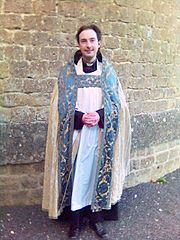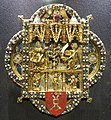Cope
The cope (from Latin pluvia "rain", hence the original name for a raincoat ), also called cappa , choir , smoke , blessing or Vesper mantle , is a liturgical garment of the western church .
Origin and shape

The cope came into use as a liturgical garment from the 10th century. It is a semicircular, sleeveless cloak or cloak- like cloak that developed from the early medieval capa , as it was worn by monks and clerics during choir prayers or processions , and is held together at the front with a buckle (a so-called choir cloak clasp ). The clasps could be designed very artistically in the Middle Ages. On the back there is usually a richly decorated shield ( clipeus ), which has developed from the hood. Originally only the hems and fringes were used as jewelry, but very artfully and preciously ornamental or figuratively embroidered pluvials were also created. The material used was often silk ; however, the material is not mandatory. The cappa, in Italy usually called cope , was worn by cantors and singers at Holy Mass , outside of Holy Mass, during processions, blessings and ordinations, also by the priest or bishop; it was also the clothing of higher dignitaries at synods and church receptions.
use
It is worn in the Roman rite as well as in the Anglican Church by those who lead the worship service to worship services where the chasuble is not used, such as solemn Vespers , devotions , processions and burials . Furthermore, at solemn church services (e.g. Vespers), the officiant's assistants and the cantors can use the pluvial when they are in the choir , as was customary in the Middle Ages. The cope is worn in the liturgical color of the day or the occasion over the choir shirt , during church services immediately before and after Holy Mass over the alb .
Sometimes the cope is also used in Evangelical Lutheran churches, for example in the Lutheran churches of North America or in the Scandinavian and Baltic Evangelical Lutheran churches in Latvia. Here it is often the bishop's robe , for example at ordinations and inaugurations.
In the extraordinary form of the Roman rite , as was generally prescribed until the liturgical reform after the Second Vatican Council , the priest also wears the cope with Asperges or Vidi aquam . In a pontifical office of this rite, the assisting priest (see Presbyter assistens ) and the bishop's assistants are also clothed with the cope. In contrast to the chasuble , the cope can also be worn by people who have not been ordained a priest.
Pope's coat (mantum)

A special form of the choir mantle represents the the Pope alone reserved Mantum even Pope coat called (lat. Pluviale , kappa , chlamys [ purpurea ] or mantus pontificalis - cf. Pontifex ) represents This was a sign once red in color and especially in the Middle Ages. the papal abundance of power, which was symbolically transferred to the newly elected Pope as a papal investiture with the immantation (literally "sheathing"), i.e. the solemn wrapping of the mantum as papal investiture . Regardless of its historical significance, the mantum was found as a longer, wider cut, with a train and particularly splendidly designed type of the choir mantle until the pontificate of Paul VI. into use. Later on, some were redesigned into choir cloaks , ie mainly shortened cloaks for special liturgical occasions - most recently under Benedict XVI. - reused.
Examples
Pope Pius III in the mantum
Magnificent choir clasp 1340/50, Aachen Cathedral Treasury
literature
- Rupert Berger : Cope . In: Walter Kasper (Ed.): Lexicon for Theology and Church . 3. Edition. tape 8 . Herder, Freiburg im Breisgau 1999, Sp. 365 .
- Joseph Braun : The liturgical paraments in the present and past. A manual of paramentics . 2nd, improved edition. Herder, Freiburg im Breisgau 1924, pp. 119–127.
- Walter Mannowsky : The Danzig Parament Treasure . Part 1: The choir coats. Brandus, Berlin 1931.
- Winfried Oppold OSB: Sacristan of the Holy Church. Reading and rubric booklet for sacristans, sextons, cantors and for senior administrators. Published following the Schott missal books. Herder, Freiburg im Breisgau 1953, p. 53.
Web links
- Search for cope with the German Digital Library
- Search for Chormantels OR Pluviale in the SPK digital portal of the Prussian Cultural Heritage Foundation
Individual evidence
- ↑ Joseph Braun: The liturgical vestments in the present and past. A manual of paramentics . 2nd, improved edition. Herder, Freiburg im Breisgau 1924, pp. 120f.
- ↑ See Rudolf Huber (ed.): Glossarium artis. Systematic specialist dictionary. Volume 4: Paraments of the Christian Churches . Third, revised and expanded edition, Saur, Munich 2002, ISBN 978-3-598-11253-9 , p. 65 ( digital copy ).
- ↑ Cf. Joseph Braun: The liturgical garb in the Occident and Orient according to origin and development, use and symbolism . Herder, Freiburg i. Br. 1907, pp. 351-352 ( digitized version ).







